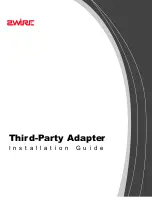
Global Panel
When set to EXT, the V-Station will sync to the sequencer’s tempo. However, that’s not to say
every syncable device in the V-Station will run in time with your sequencer - they will have to be
individually set to sync to incoming MIDI clock. The only exception to this is the arpeggiator
which, by default, will sync to your sequencer. Perhaps the following diagram will make things
clearer:
OFF
OFF
OFF
OFF
OFF
OFF
DIVIDER
DIVIDER
DIVIDER
DIVIDER
DIVIDER
DIVIDER
DIVIDER
LFO 1
LFO 2
DELAY TIME
CHORUS LFO
EQ LFO
PANNING LFO
ARPEGGIATOR
CLOCK
The above is the default setting for the V-Station. External sync is selected and, by default, the
arpeggiator is synchronised to the sequencer’s tempo. However, the other syncable devices
are, by default, set to free-run at rates determined by their own speed or time controls. If you
want any of the syncable devices to synchronise to the sequencer’s tempo, they should be
specifically set with the device’s SYNC RATE parameter.
Note : Most sequencers do not transmit MIDI Clock while they are stopped. Synchronisation of
the V-Station to MIDI Clock will only be possible while the sequencer is actually recording or
playing.
When set to INT, the V-Station’s own internal clock is used for synchronisation purposes. The
tempo of the internal clock is controlled by the TEMPO knob found in the Arpeggiator section.
VEL CURVE select LEDs
The response to MIDI velocity information may be set using this function.
A setting of SOFT indicates that smaller changes in velocity (a lighter playing style) will create a
large change in response to velocity, be it volume or any other modulation destination that
velocity is routed to.
A setting of HARD indicates that higher changes in velocity - a much harder playing style, will
create large changes in response to velocity.
73
GLOBAL panel / Operation
















































